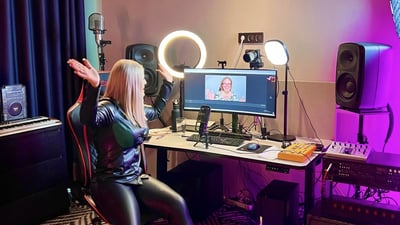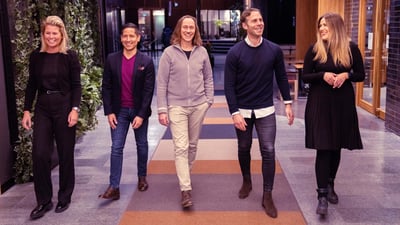We’re heading into fall with a thought-provoking fresh live stream!
On September 15th, Sara Dalsfelt, Adway’s Senior Advisor of Digital Talent Acquisition, sat down with the # 1 Inclusion specialist in the UK: Joanne Lockwood, Founder and CEO of SEE Change Happen.
Nearly 90% of companies are concerned with reducing bias in their talent acquisition process, so this was the perfect opportunity to dig DEEPER into the layers of conscious inclusion by:
- Tackling the Myth of Meritocracy
- Deciding how we value “difference”
- Discovering the powers of diversity of thought and perspective
- Deciphering what is a “cultural fit”
- Taking inventory of your pitfalls (because there’s no magic bullet!)
If you’re ready to watch the entire insight-packed session, the recording is below. If you’d rather sit down and take in the biggest takeaways, keep reading the summarised transcript from the interview below.
It’s time to make a mental shift to be consciously inclusive and build that consciousness right intothe TA funnel.
Background Check
Joanne Lockwood is the Founder and CEO of SEE Change Happen and describes herself as an Inclusion and Belonging Specialist and Speaker who works with organisations throughout the UK, Europe and elsewhere to bring the kind of culture change that allows people to thrive and perform at their best.
Her mantra is “smile, engage and educate,” and she passionately believes that “people are people” who, no matter who they are, deserve to be treated with dignity and respect.
Is Hiring For Diversity Hiring For Second Best?
In a nutshell: of course it’s not!
However, that seems to be the popular belief. We all-too-often see that the pervasive monoculture in organisations still favors white men.
There’s a major association that “the default” is best: maleness, straightness, whiteness. We’ve been brainwashed to believe that all these attributes are “better” than the rest. This means we seldom see enough representation of difference.
What we need to do to squash this mentality is to reframe. Stop seeing candidates as “diversity hires.” Don’t hire for diversity in the first place. Create representation and voices in the workplace and recognize that those attributes are just as valid, if not more valid, as time served, past performance, etc.
Attracting diverse candidates means hiring for capability and potential, because we already know we can train certain skills down the line. It’s the passion, the attitude, the hunger and the ability to bring new thinking to the table that you can’t train or find on paper.
How Do We Value Difference?
For starters, recognize that many people are scared of difference.
How often do we hear the debates around “culture fit?” and “values fit?” It seems as if some organisations think they want difference, but their actions and cultures don’t align with the intention, leaving the “different” people as outliers inside and outside the workplace.
To start to truly value difference, we need to avoid blind spots, uphold difference and take advantage of the power of many different thoughts. And, if we let those thoughts conflict, we can’t let the power of the pervasive monoculture win.
Why it’s Important to Start With “Why?”
Why does diversity and inclusion fundamentally matter to you as a person? And why does it matter to you as an organisation?
Starting with “it’s the right thing to do” is a good baseline, but what is the business argument for “why?” To make D&I sustainable, there has to be a business outcome. Understanding why diversity of thought, diversity of opinion and diverse representation for the business’s customers and key stakeholders is important supports the business case — or the why— for the organisation.
From there, we can start to explore the “when,” the “who,” the “where” and the “how.”
How Data Fuels Diversity WhenRecruiting Talent
Another key part of the diversity equation is, you guessed it: data!
It’s crucial to whittle down what the organisation’s talent acquisition metrics are and what they are trying to achieve. Once that information can be quantified, recruiters can start their search for the top of the funnel, assess the steps of the recruitment process, determine drop-off rates and where the snags are occurring, and continuously refine their recruiting efforts accordingly.
Other key questions for organisations to ask include:
Because, if you’re trying to be as unbiased as possible, you’re probably anonymizing the talent acquisition process. You’re removing names and qualifications and keeping the application and interviews simple with objective questions. But at that point, you don’t know what’s in the funnel, making it difficult to target the very talent acquisition metrics you want to check.
It’s equally essential to be able to admit when no one in the funnel has ticked all the boxes. If you haven’t found someone who brings another dimension or a different perspective to the table, it’s time to go back to the drawing board.
Data is, thus, the secret sauce to diversity in recruitment!
Joanne’s Top 3 Takeaways
- Start with your “why.” Become awakened to the need for change, the needs of others, and the fact that your organisation will be strengthened through more diverse thinking.
- Be prepared to challenge yourself and be challenged by others as to why you think something different. By doing that, you’ll hopefully catch biases and can mitigate accordingly.
- Spend more time questioning the rejections than you do the acceptances. That can be a very enlightening exercise to explain where your biases and blind spots exist in the talent acquisition process.
Questions From the Audience
Annahita Amini, People Associate,The Talent Company
What are your thoughts on Cognitive Diversity and its connections to Innovation? We tend to recruit those who think alike, which puts us in a status quo when perspectives aren’t broadened despite (sometimes) different appearances. What does Joanne see as important tools to bring with her in the process to enable and emphasize different types of diversity?
-
It’s important (as seen in this question) to think about the multiple dimensions of diversity:
- There’s inherent diversity, sexual gender, ethnicity, etc. all are unchangeable.
- Acquired diversity, on the other hand, encompasses education, life experiences, etc.
-
Cognitive diversity speaks to your ways of thinking, how you see things, how creative or logical you are, etc.
- Diversity initiatives are too often focused on inherent diversity, specifically how people look. And, while representation of people of different colors and genders is important, it’s also important that we don’t assimilate people with the same types of cognitive tendencies.
Lina Noren, Talent Partner,The North Alliance
How can we prevent gender coding in ad-languages when most**job recruitment ads are written in English but for a non-native English speaking audience? I, myself, have studied the connection between language and gender perspective and I’m really curious about Joanne’s thoughts.
- Can you find yourself an external focus group? Can you ask people in your target audience or other groups to share their specific thoughts with you?
- Does this role appeal to you?
- What is it about this role that turns you off?
-
If you have a large enough organisation, you can ask your gender groups, pride groups, disability groups or ethnicity groups how your sample recruitment ads read. The more perspectives, the better!
- Additionally, you can connect with your passive candidate audience through social media and ask them how they would like to be approached.
Annahita Amini, People Associate,The Talent Company
Can Joanne mention 1-3 key metrics that can be used in Talent to indicate progress in diversity?
It all comes down to data, and different “rooms” within the organisation:
- Front door to diversity: Metrics that identify how we are hiring and who’s arriving/ being hired by the organisation.
- Living room to diversity: Metrics that identify the experience of people within the organisation: promotion, opportunity, pay, socializing, review, growth.
- Back door to diversity: Metrics around who is leaving and why they’re leaving.
Jim D’Amico, Board Member & Past President,ATAP
CV or resume is a horrible tool. One of the biggest issues with CV/resume and the process is it is designed to “exclude.” Very few TA organizations, and I mean VERY FEW, take the perspective of looking to include vs. exclude candidates.
-
Many TA professionals are PROUD of the fact that they don’t read the cover letter! How can a person tell someone about themselves unless they can narrate it? The CV is full of bullets and facts, but a perspective and a value-add is not found on the same page. Joanne would like to see MORE cover letters, and less CVs.
-
Working with attributes, potential and behavior as early as possible in the hiring process will move us away from the archaic concept of CVs and into the future of TA.
Annahita Amini, People Associate,The Talent Company
If Joanne had advice to offer a talent team on a growth journey, what would that be?
-
If you’re thinking specifically about building a more equitable pipeline process for onboarding talent, the first bit of advice would be to identify it. Put it on the table and say you want to do it. It, again, comes back to “why?” Why do you want to grow? Why do you want to become more diverse and inclusive?
-
Once you understand why you want to change gender parity in X number of years, then you can make targets in specific areas, using metrics to create a feedback loop where you can cause correct, refocus and retry.
If you’re looking to grow in terms of belongingness, gather the feedback: engagement surveys, candidate experiences and one-on-one interviews.








